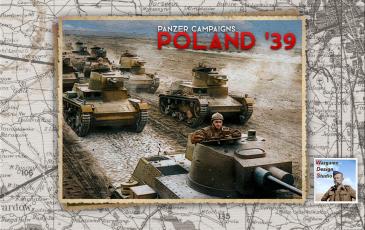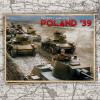0901_01a_Campaign - Allied AI - PzC 31 Poland '39

b59375da7db50f7a9280.jpg) 0 - 0 - 0
0 - 0 - 0
4f09d1569063283d124d.jpg)
| Rating: | 0 (0) |
| Games Played: | 0 |
| SM: | 8 |
| Turns: | 158 |
| Type: | Stock |
| First Side: | Axis (Poland-39) |
| Second Side: | Allies (Poland-39) |
Date: September 1st, 1939 - Size: Huge - Location: Poland
Intended for play as Axis Human vs Allied AI or Head to Head
Scenario Briefing: With the signing of the Munich Agreement on September 30th, 1938, Neville Chamberlain proudly declared “peace for our time.” Less than a year later, when asked by Mussolini’s foreign minister whether Germany wanted Danzig or the Polish corridor, Joachim von Ribbentrop gave a direct answer: “No, not that anymore. We want war.”
The six years that had passed since Hitler had ascended to power had tested the resolve of Europe. He rebuilt Germany’s army in open defiance of the Versailles Treaty and the Anglo-French did nothing. The occupation of the Rhineland and the annexation of Austria were met with mere protest. At Munich, Chamberlain and Daladier sold out Czechoslovakia in hopes that Hitler’s territorial ambitions might be satiated, and months later the Czechoslovak state collapsed with hardly a shot fired. Memel was next, ceded to Germany by Lithuania shortly after the fall of Czechoslovakia. British efforts to form a grand military alliance in central and southern Europe and to court the Soviet Union as an ally against Germany came to nothing. It was clear that the policies of appeasement and containment had failed. Now Hitler demanded Danzig and the corridor. Attempts at mediation failed. The Polish Republic would not acquiesce to Hitler’s demands and Hitler would not back down. Poland had drawn a line in the sand: Hitler would not acquire Danzig or any piece of Polish territory except by war.
At 04:47 on September 1st, the guns of the German battleship Schleswig-Holstein opened fire on the Polish fortress at Westerplatte. Already the Luftwaffe had bombed Tczew and Wielun and German irregulars had seized mines and industrial targets in Silesia. The invasion was underway, and Europe was plunged into a darkness that would last for nearly six years.
Given the numerical and technical superiority of the Wehrmacht and the threat posed by the Red Army in the East, the Battle of Poland was, perhaps, a lost cause. The border defenses could not be held, the Polish army could not match the operational tempo set by Germans, and Poland had no answer to the Luftwaffe’s relentless bombardment of its cities. Nonetheless, the Polish soldier met the invader with utmost courage and tenacity. Polish infantrymen would turn back the armored onslaught at Mlawa and fight to the last round at Tomaszow Lubelski. Cavalrymen would deliver the Germans a bloody nose at Mokra. The air force, though outnumbered by more than 2:1 and technically outmatched, fought a skilled campaign and continued to make its presence felt deep into the battle. At Gdynia, sailors and civilian volunteers aided the army in a heroic nineteen-day defense. And on the Bzura River, the Polish army wiped out an entire German division in the largest Allied ground offensive prior to 1941. Even after defeat, Polish soldiers would continue the war from abroad where they would be known as "The First to Fight.”
Recommended Rules: (Default)
Alternative Assault Resolution, Artillery Set Up, Recon Spotting, Virtual Supply Trucks, Optional Surrender, Low Visibility Air Effects, Quality Fatigue Modifier, Counterbattery Fire, Night Fatigue, Programmed Weather.
Additionally, Delayed Disruption Reporting will provide a more challenging experience for the attacking player.
Design Notes:
1. This short version of the scenario lasts from September 1st-16th, ending before the Soviet invasion.
2. This scenario uses conditional reinforcements. The arrival of most Polish and some German reinforcements are tied to control of certain objective hexes.
3. Many objective hexes near the Polish-German border expire after a time. Some may be very difficult for the German player to capture and are not necessarily required for a German victory. Their purpose is to penalize the Polish player should he choose the abandon the border very early in the scenario.
4. There are several 0-point objective hexes on the map. These are tied to conditional reinforcements and do not have any value otherwise. Though these objectives do not have a point value assigned, control of these these objectives affects the arrival of reinforcements.
5. The German player has strategy options concerning the arrival of air landing troops. These reinforcements are conditional and are tied to the control of various objective hexes inside Poland. If the German player selects a location that he does not control, the reinforcements will not arrive.
Intended for play as Axis Human vs Allied AI or Head to Head
Scenario Briefing: With the signing of the Munich Agreement on September 30th, 1938, Neville Chamberlain proudly declared “peace for our time.” Less than a year later, when asked by Mussolini’s foreign minister whether Germany wanted Danzig or the Polish corridor, Joachim von Ribbentrop gave a direct answer: “No, not that anymore. We want war.”
The six years that had passed since Hitler had ascended to power had tested the resolve of Europe. He rebuilt Germany’s army in open defiance of the Versailles Treaty and the Anglo-French did nothing. The occupation of the Rhineland and the annexation of Austria were met with mere protest. At Munich, Chamberlain and Daladier sold out Czechoslovakia in hopes that Hitler’s territorial ambitions might be satiated, and months later the Czechoslovak state collapsed with hardly a shot fired. Memel was next, ceded to Germany by Lithuania shortly after the fall of Czechoslovakia. British efforts to form a grand military alliance in central and southern Europe and to court the Soviet Union as an ally against Germany came to nothing. It was clear that the policies of appeasement and containment had failed. Now Hitler demanded Danzig and the corridor. Attempts at mediation failed. The Polish Republic would not acquiesce to Hitler’s demands and Hitler would not back down. Poland had drawn a line in the sand: Hitler would not acquire Danzig or any piece of Polish territory except by war.
At 04:47 on September 1st, the guns of the German battleship Schleswig-Holstein opened fire on the Polish fortress at Westerplatte. Already the Luftwaffe had bombed Tczew and Wielun and German irregulars had seized mines and industrial targets in Silesia. The invasion was underway, and Europe was plunged into a darkness that would last for nearly six years.
Given the numerical and technical superiority of the Wehrmacht and the threat posed by the Red Army in the East, the Battle of Poland was, perhaps, a lost cause. The border defenses could not be held, the Polish army could not match the operational tempo set by Germans, and Poland had no answer to the Luftwaffe’s relentless bombardment of its cities. Nonetheless, the Polish soldier met the invader with utmost courage and tenacity. Polish infantrymen would turn back the armored onslaught at Mlawa and fight to the last round at Tomaszow Lubelski. Cavalrymen would deliver the Germans a bloody nose at Mokra. The air force, though outnumbered by more than 2:1 and technically outmatched, fought a skilled campaign and continued to make its presence felt deep into the battle. At Gdynia, sailors and civilian volunteers aided the army in a heroic nineteen-day defense. And on the Bzura River, the Polish army wiped out an entire German division in the largest Allied ground offensive prior to 1941. Even after defeat, Polish soldiers would continue the war from abroad where they would be known as "The First to Fight.”
Recommended Rules: (Default)
Alternative Assault Resolution, Artillery Set Up, Recon Spotting, Virtual Supply Trucks, Optional Surrender, Low Visibility Air Effects, Quality Fatigue Modifier, Counterbattery Fire, Night Fatigue, Programmed Weather.
Additionally, Delayed Disruption Reporting will provide a more challenging experience for the attacking player.
Design Notes:
1. This short version of the scenario lasts from September 1st-16th, ending before the Soviet invasion.
2. This scenario uses conditional reinforcements. The arrival of most Polish and some German reinforcements are tied to control of certain objective hexes.
3. Many objective hexes near the Polish-German border expire after a time. Some may be very difficult for the German player to capture and are not necessarily required for a German victory. Their purpose is to penalize the Polish player should he choose the abandon the border very early in the scenario.
4. There are several 0-point objective hexes on the map. These are tied to conditional reinforcements and do not have any value otherwise. Though these objectives do not have a point value assigned, control of these these objectives affects the arrival of reinforcements.
5. The German player has strategy options concerning the arrival of air landing troops. These reinforcements are conditional and are tied to the control of various objective hexes inside Poland. If the German player selects a location that he does not control, the reinforcements will not arrive.





















